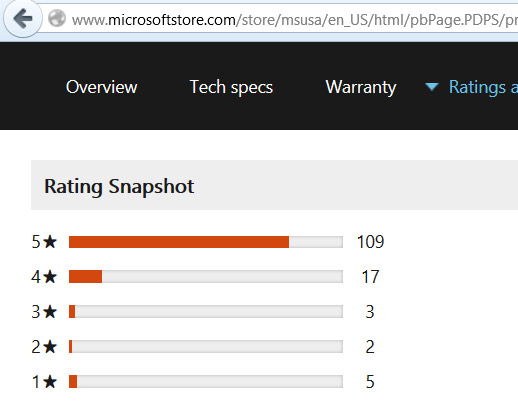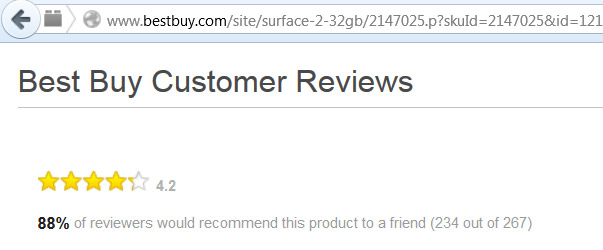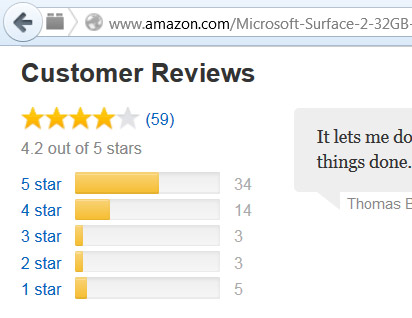- What happened to the first generation of Surface?
- When pundits are not.
- Why Windows RT?
- How many “apps” do you need?
- My Surface 2
- Is the Microsoft Surface 2 right for you?
- Tips
- Addendum (January 2014)
January 2014: Where are we now? Stock levels
Sometime in November 2013, potential buyers of the second generation Microsoft Surface products began to see stock limitations. This alone didn’t mean much, but consider that the second generation Surfaces were released only October 22, and I’m not talking about the pre-release “sell out” with preorders (and backorders). I watched this with some interest because, surely, Microsoft wouldn’t be so idiotic as to let a holiday season pass it by, right? Black Friday in the United States came and went, taking with it large chunks of the first generation Surface RT thanks to heavy discounts at Best Buy and so on, but the second generation availability was quickly exhausted or simply nonexistent except for the most expensive “fringe” Surface Pro 2 units. All of December was essentially met with “sold out” notices across a number of Microsoft’s official retailers, including their own online store.
Well, there are three things going on, but the first two–
First, Microsoft decided to under-produce Surface stock compared to 2012. This is understandable, and every economist/technologist with any interest in these things fully expected Microsoft to react strongly to the now-infamous write-down. At first blush, this might seem to be a safe business decision.
Second, thanks to both improved marketing and product (hardware upgrades, Windows 8.1, and free Outlook RT for Windows RT devices), consumer interest rose comparatively to the first launch.
So we have a double whammy of sorts: purposefully low stock and higher consumer interest, compared to the first launch. Now, under normal circumstances, if a consumer couldn’t get her hands on a Surface, she could simply opt for another Windows 8 device, and Microsoft would still “win” in that regard. Some commentators suggested that coinciding the low stock with higher demand allowed Microsoft to rapidly move unsold Surface RT units in the critical Black Friday period, and I think that’s a reasonable assessment. That does not, however, explain continued nonexistence of Surface 2/Pro 2 units after the November Black Friday blitz into December and now January.
But the third factor is where Microsoft is currently stumbling and this may prove to be the real blotch on an otherwise much improved second Surface product release: The existing customer. Specifically, existing customers who are the unlucky few requiring warranty exchanges due to any number of potential product faults cannot take advantage of the otherwise well-reputed Microsoft customer service for a painless exchange. Part of this issue was certainly made worse by Microsoft’s own hand in that bad firmware release for the Surface Pro 2 in December, but other second generation Surface owners requiring an exchange would run into the same crippling stock problem. (I feel bad for the service techs who had nothing to do with the business decisions regarding low stock levels, though. Bad Microsoft.)
What I think Microsoft should do: Per warranty exchange issues with the lack of stock, Microsoft should allow exchanges with any other retail-comparable device in their store that happens to be in stock, along with a gift card refund for the Complete warranty if someone bought that. This would be a matter of goodwill, really, and because the exchange would be for another Windows 8 device, Microsoft still “wins.” Right now, there is no word anywhere as to Microsoft’s plans for increasing stock levels to where they should be.
How about the new owners?
I did a small graphical survey of U.S. user reviews across the internet to see where the average review ratings currently sit after the holiday season, specifically for the Surface 2 because that has higher adoption resistance compared to the Pro line. It’s still early (and not helped by the general low stock issue), but actual user reviews paint a pretty picture compared to the “pundit” reviews for second generation Surface. Certain official MS vendor sites like Staples do not have a significant number of reviews to count yet–only 13 for the Surface 2 last I checked (4.5 stars).

4.6/5 star average on Microsoft’s store website.

4.2/5 stars average at Best Buy.

4.2/5 stars average on Amazon. Now, I think it’s important to stress that Amazon is not an official Microsoft Surface vendor. Only third party “marketplace” sellers who bought Surface units from official MS vendors or MS itself are selling these on Amazon, and they significantly increase the price while lying about the official list price. Because of this highly dubious practice, a handful of reviews are actually only 1-star as some users attempt to educate other buyers that the Amazon price is completely out of line–the problem with this practice is that many potential buyers only interpret the star rating as indicative of the product itself (which it should be) and not the underlying purchase service. What that means is that removing the non-product ratings about the Amazon 3rd party thieves, and considering that people would be happier buying a “cheaper” product (compared to official prices), the Amazon rating is realistically higher.

I don’t recommend buying a Surface from Amazon for the above reason, though if you were truly desperate due to the stock problem, just keep in mind that you’d be paying extra.
We’ll see what happens by the end of this year, 2014. The power cover is still supposed to be coming, and with Microsoft’s purchase of Nokia, there may be additional Surface models coming down the pike.